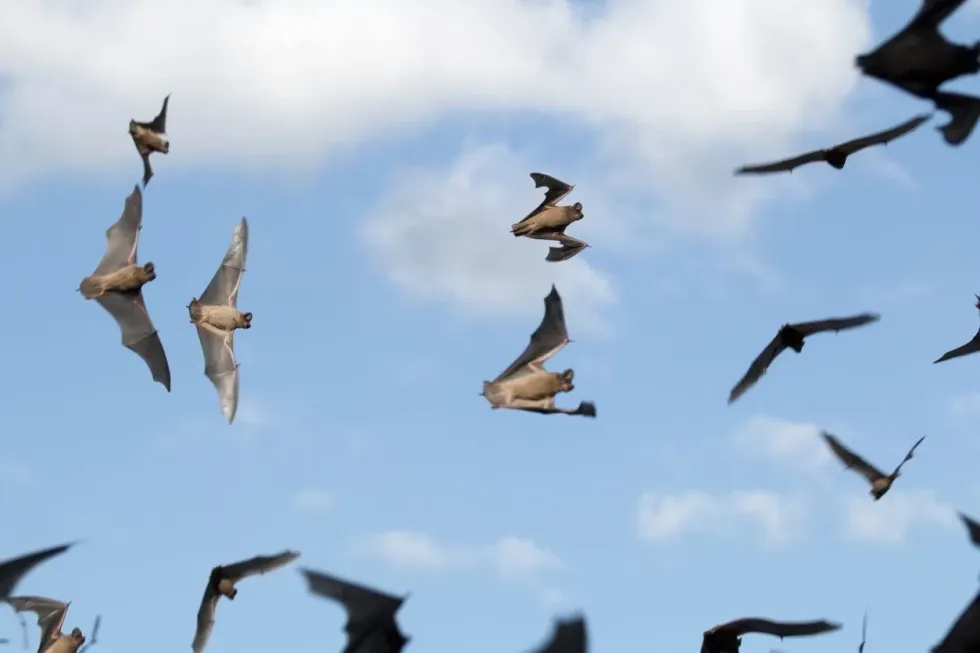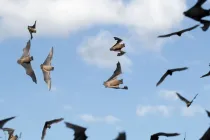The Mexican Free-tailed Bat (Tadarida brasiliensis) would be considered a species of medium-sized bats with fur that is a mixture of red, dark brown, and gray.
Other names for this species would be Guano bats, Brazilian Free-tailed Bats, and Mastiff Bats. Common features of Free-tailed Bats would be wide, black, forward-pointing ears and wrinkled lips.
Their tails extend for more than a third of their tail membranes.
With long and narrow wings, they can be spotted from up close. Coming from the Molosiddae family of bats, Mexican Free-tailed Bats are different from bats like the Hoary Bat and the Eastern Red Bat that come from the Vespertilionidae family, even though they seem to share similar looks and features.
With major colonies found in the Southern United States (Texas), Mexico and northern parts of South America, Central America, and San Antonio, it is known that they flourish when in huge colonies.
If you liked reading these facts, you could also check out our facts on other mammals such as the hoary bat or masked palm civet.
Mexican Free-tailed Bat Interesting Facts
What type of animal is a Mexican Free-tailed bat?
The Mexican Free-tailed Bat is a medium-sized bat.
What class of animal does a Mexican Free-tailed bat belong to?
Mexican Free-tailed Bats come under the class of Mammals, or Mammalia
How many Mexican Free-tailed bats are there in the world?
The estimated population of the Mexican Free-tailed Bats is around 120 to 150 million. Interestingly, up to one million bats can be found in a single cave, this is because they usually roost in giant colonies.
Where does a Mexican Free-tailed bat live?
Mexican Free-tailed Bats make their habitat in semi-arid regions.
Mexican Free-tailed Bats live in various places around the world, but usually in the semi-arid regions of South America. They tend to dwell in caves and may find shelter under houses, bridges, and other architectures. They can be easily found in large numbers in the state of Texas.
What is a Mexican Free-tailed bat's habitat?
Mexican Free-tailed Bats live in bracken caves, tunnels, and bridges. Up to one million bats can roost in bracken caves, and a lot of them have been seen in San Antonio, Texas.
Who do Mexican Free-tailed bats live with?
Mexican Free-tailed Bats roost in large colonies filled with millions of bats in the bracken caves. The Free-tails roost in large colonies, and can be found in parts of the world like San Antonio, Texas. San Antonio, Texas is known to be home to a particularly large colony.
How long does a Mexican free-tailed bat live?
The average lifespan of a Mexican Free-tailed Bat is usually around 18 years, but can be longer or shorter depending on health and circumstance.
How do they reproduce?
Mexican Free-tailed Bats (Tadarida brasiliensis) reproduce by the males signaling the females to mate. They create this signal by spreading a specific scent around. The males can mate with several females, and the mother, interestingly enough, gives birth while hanging upside down.
After the birth, they leave the pup to fetch food and grow on its own. The peculiar stance of a female Mexican Free-tailed Bat hanging upside down to give birth, is actually a common practice in bats while conceiving. The baby bats are known as pups.
What is their conservation status?
The conservation status of Mexican Free-tailed Bats is currently listed as Least Concern. The population of Mexican Free-tailed Bats is stable, according to Bat Conservation International. They have a huge number of colonies in Texas and Mexico, and these colonies don't seem to be decreasing at a worrying rate.
Mexican Free-tailed Bat Fun Facts
What do Mexican Free-tailed bats look like?
They are medium-sized bats who have a reddish to dark brown or grey color to their fur. They also have broad, black and forward pointing ears, with eyes like black pearls, and wrinkled lips.

*Please note than this is an image of a fruit bat not a Mexican Free-tailed Bat. If if you have an image of a Mexian Free-tailed Bat please let us know at hello@kidadl.com
How cute are they?
Mexican Free-tailed Bats (Tadarida brasiliensis), can be considered cute as they are furry, medium-sized bats with large rounded ears. As they are not large bats, they may qualify as non-threatening and cute.
How do they communicate?
Mexican Free-tailed Bats (Tadarida brasiliensis) communicate just like any other bat. By using sound. During the night, they use echolocation to hunt. For reproductive signals, the males give off a scent to communicate with the females. The usual voice of a Mexican Free-tailed Bat sounds like a screech.
How big is a Mexican Free-tailed bat?
Mexican Free-tailed Bats are a fairly small bat. They weigh around 0.02-0.03 lb (11.3-14.1 g) and don't grow more than 4-5 in (10-12 cm).
How fast can a Mexican free-tailed bat fly?
Mexican Free-tailed Bats can fly up to the speed of 47 mph (75 kmph). Any flying swarm of bats, usually contains a huge number of the animal.
How much does a Mexican free-tailed bat weigh?
Mexican Free-tailed Bats weigh 0.02-0.03 lb (11.3-14.1 g). Although they look like they weigh more, this is just because of their tail.
What are the male and female names of the species?
The male and female of this species have no specific name, but you may use the scientific name for a Mexican Free-tailed bat (Tadarida brasiliensis).
The other subspecies of this bat also include: Tadarida brasiliensis antillularum, Tadarida brasiliensis bahamensis, Tadarida brasiliensis constanzae and Tadarida brasiliensis cynocephali.
What would you call a baby Mexican free-tailed bat?
A young Mexican Free-tailed Bat (Tadarida brasiliensis) is known as a pup and they are relatively small. The pup can be identified by comparing its size to other bats in the colonies. The young ones can have an average lifespan of 18 years
What do they eat?
These cave-dwelling bats are primarily insectivores, this means they consume tons of insects. From young ones to old, the Mexican Free-tailed Bat can consume a giant amount of insects in one day.
The number can be as high as 250 tons of insects being consumed on a daily basis, per bat. This can result in free pest control, as the insect population is kept in check. Even though they live in big colonies in their cave, the bats themselves are prone to attack from larger species like owls.
Are they aggressive?
Even though they might not be considered aggressive, it is advised not to confront Mexican Free-tailed Bats in their roosts. There have been past reports where the species showed significant aggressive behavior due to a virus affecting the roosts. The species has shown an aggressive reproductive stance during mating season when the male powers over the female.
Would they make a good pet?
Mexican Free-tailed Bats are wild animals that prefer to dwell in caves, and form big roosts. Removing any creature from its natural state is not advised.
Even though the cave creatures might make fine pets, there is always a chance of the bat contracting diseases like rabies which means it is not suitable or advised to keep these animals as pets.
Did you know...
A mother bat finds her baby in a crowded roost by its sounds and scent. If the pup falls while hanging, the mother won't try to help.
It is said that 20 million bats live in the Bracken Cave in San Antonio, Texas. Their tails are half as long as their body. Mexican Free-tailed Bats are the official flying mammal of the state of Texas.
How many insects can a Mexican free-tailed bat eat in one night?
A typical Mexican Free-tailed Bat diet will involve tons of insects. A colony of bats can eat up to 250 tonnes (250,000 kg) of insects (especially moths) in one night. 250 tonnes (250,000 kg) is around the weight of two blue whales.
When do Mexican free-tailed bats migrate?
Texas and Mexico are the major places where these Mexico Free-tail bats are found. Mexican Free-tailed Bat migration is a sight to behold as millions of bats fly in groups. The speed of a Mexican Free-tailed Bat can be a great advantage for the colonies to migrate faster.
They set flight just before winter takes over. Specifically, you can spot these bats flying south to live in caves in South America (usually Mexico).
Their flight pattern has these bats coming back north in the starting months of the year. People in Central America (Texas state) have spotted Mexican Free-tailed Bats flying around in February. A colony of flying bats is a marvel to observe indeed.
Here at Kidadl, we have carefully created lots of interesting family-friendly animal facts for everyone to discover! Learn more about some other mammals including italian wolves, or asian palm civets.
You can even occupy yourself at home by drawing one of our Mexican dancer coloring pages.









